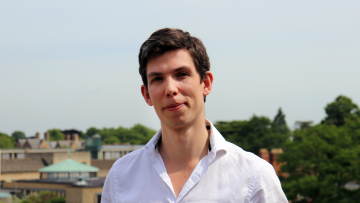2:30 -3.00 Will Turner (CDT Student, Imperial College London)
Topologies on unparameterised path space
The signature of a path is a non-commutative exponential introduced by K.T. Chen in the 1950s, and appears as a central object in the theory of rough paths developed by T. Lyons in the 1990s. For continuous paths of bounded variation, the signature may be realised as a sequence of iterated integrals, which provides a succinct summary for multimodal, irregularly sampled, time-ordered data. The terms in the signature act as an analogue to monomials for finite dimensional data: linear functionals on the signature uniformly approximate any compactly supported continuous function on unparameterised path space (Levin, Lyons, Ni 2013). Selection of a suitable topology on the space of unparameterised paths is then key to the practical use of this approximation theory. We present new results on the properties of several candidate topologies for this space. If time permits, we will relate these results to two classical models: the fixed-time solution of a controlled differential equation, and the expected signature model of Levin, Lyons, and Ni. This is joint work with Thomas Cass.
3.05 -3.35 Ross Zhang (CDT Student, University of Oxford)
Random vortex dynamics via functional stochastic differential equations
The talk focuses on the representation of the three-dimensional (3D) Navier-Stokes equations by a random vortex system. This new system could give us new numerical schemes to efficiently approximate the 3D incompressible fluid flows by Monte Carlo simulations. Compared with the 2D Navier-Stokes equation, the difficulty of the 3D Navier-Stokes equation lies in the stretching of vorticity. To handle the stretching term, a system of stochastic differential equations is coupled with a functional ordinary differential equation in the 3D random vortex system. Two main tools are developed to derive the new system: the first is the investigation of pinned diffusion measure, which describes the conditional distribution of a time reversal diffusion, and the second is a forward-type Feynman Kac formula for nonlinear PDEs, which utilizes the pinned diffusion measure to delicately overcome the time reversal issue in PDE. Although the main focus of the research is the Navier-stokes equation, the tools developed in this research are quite general. They could be applied to other nonlinear PDEs as well, thereby providing respective numerical schemes.
3.40 - 4.25pm Dr Cris Salvi (Imperial College London)
Signature kernel methods
Kernel methods provide a rich and elegant framework for a variety of learning tasks including supervised learning, hypothesis testing, Bayesian inference, generative modelling and scientific computing. Sequentially ordered information often arrives in the form of complex streams taking values in non-trivial ambient spaces (e.g. a video is a sequence of images). In these situations, the design of appropriate kernels is a notably challenging task. In this talk, I will outline how rough path theory, a modern mathematical framework for describing complex evolving systems, allows to construct a family of characteristic kernels on pathspace known as signature kernels. I will then present how signature kernels can be used to develop a variety of algorithms such as two-sample hypothesis and (conditional) independence tests for stochastic processes, generative models for time series and numerical methods for path-dependent PDEs.
4.30 Refreshments


